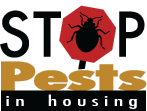How much does an IPM program cost?
There are many components to an IPM program so it’s hard to give a total dollar amount. Boston Housing Authority found their budget for pest control increased for the first few years of IPM and then went down as they brought pest problems under control and completed long-lasting exclusion work. But this was before bed bugs. Now, PHAs have to fund bed bug treatments at great expenses without achieving property-wide control. When you look at your current pest control expenses, factor in what you are getting for that price. Is it only pesticide application without ever gaining control of pests? Does your program cover the risk of reintroduction?
Costs
Your budget line for pest control will now involve the following expenses:
- Supplies and time for maintenance staff or contractors to make repairs and do exclusion work.
- Materials you make available to residents at a reduced or no cost. Examples include educational materials, insect monitors, mattress encasements, and cleaning supplies. Note: PHAs should not distribute pesticides to residents or staff.
- Supplies and time to help residents who can’t clean or organize.
- Pesticide purchases or IPM service (depending on whether you have licensed in-house applicators or contract out). A very rough estimate is that IPM service will cost $7–$14 per unit per month.
Benefits
PHAs report the following benefits of an IPM program:
- Reduced levels of infestation.
- Reduced pesticide applications resulting in a healthier environment and lower cost if pest control is done in-house.
- Reduced work orders and complaints about pests.
- Increased communications and cooperation between staff, residents, and contractors.
- Increased job satisfaction.
- Safer and more decent housing portfolio.
A business case
"The New England Asthma Regional Council produced a business case demonstrating that education and in-home multi-faceted environmental interventions are sound investments for patients with persistent asthma . . . . Given the high costs of medications and hospital visits for patients and payers, pest management demands consideration by the health sector as a reasonable intervention for asthma patients. An analysis of the research on costs and health benefits of pest management demonstrates that, relative to standard clinical methods of asthma management, IPM education and services are cost-effective interventions for certain high-risk asthma patients.”
